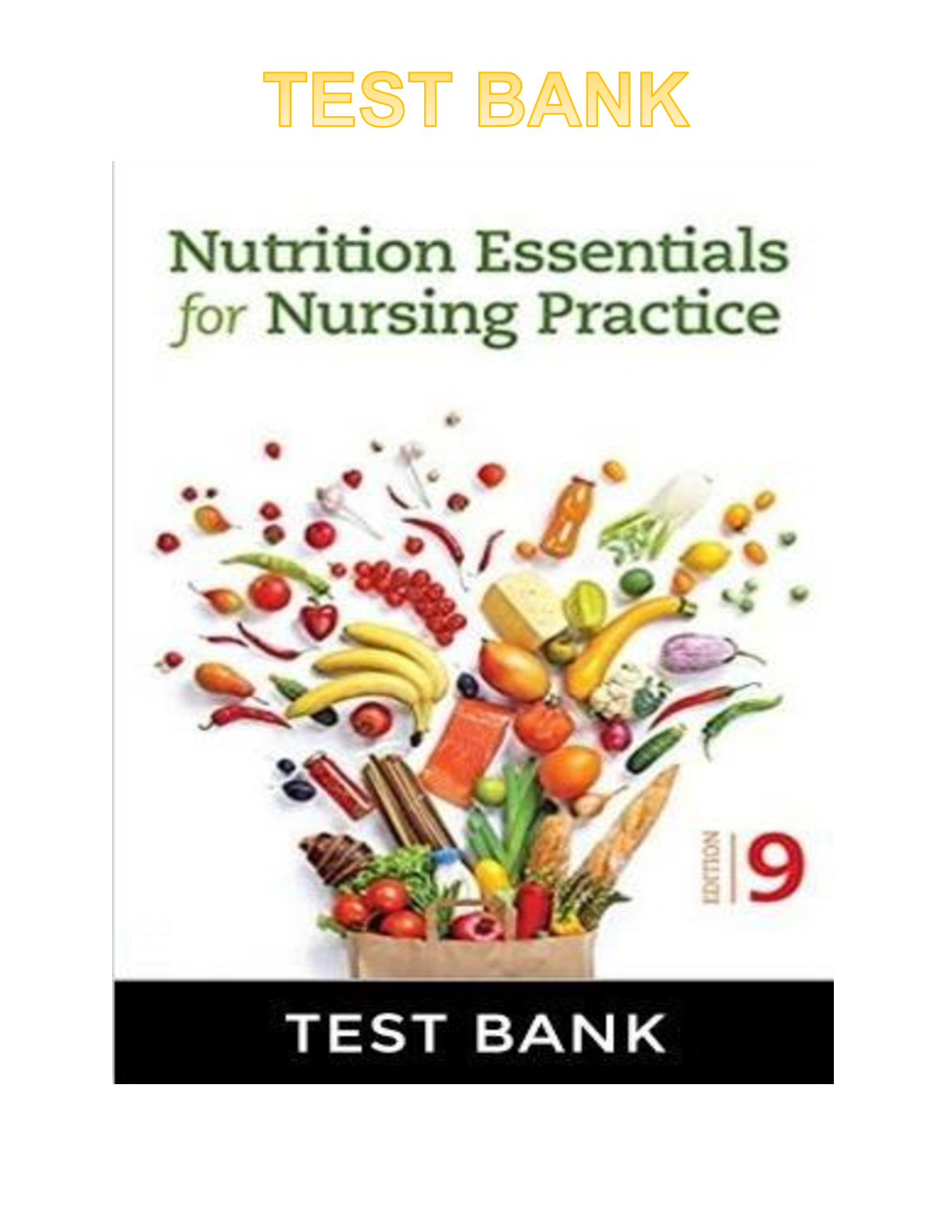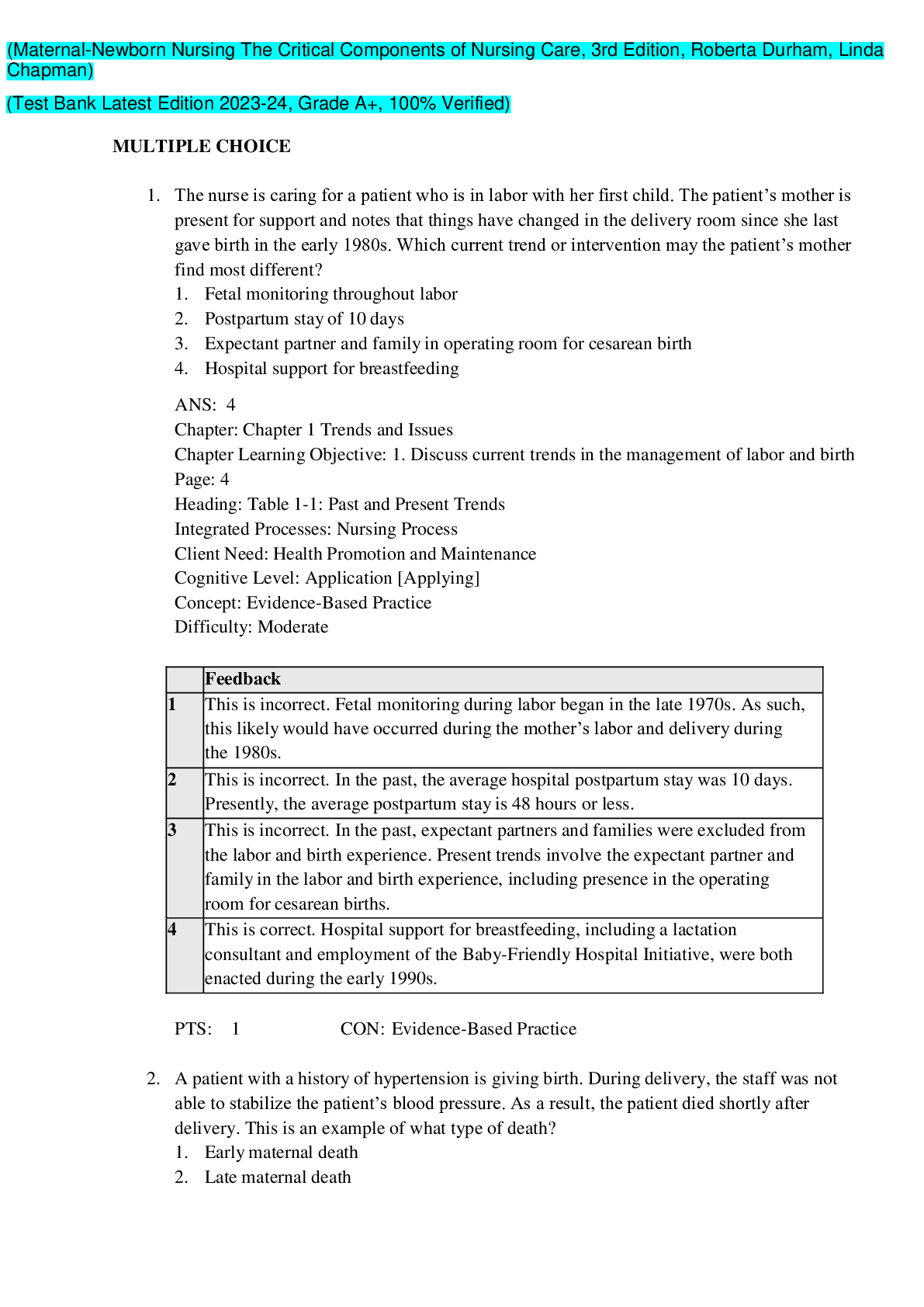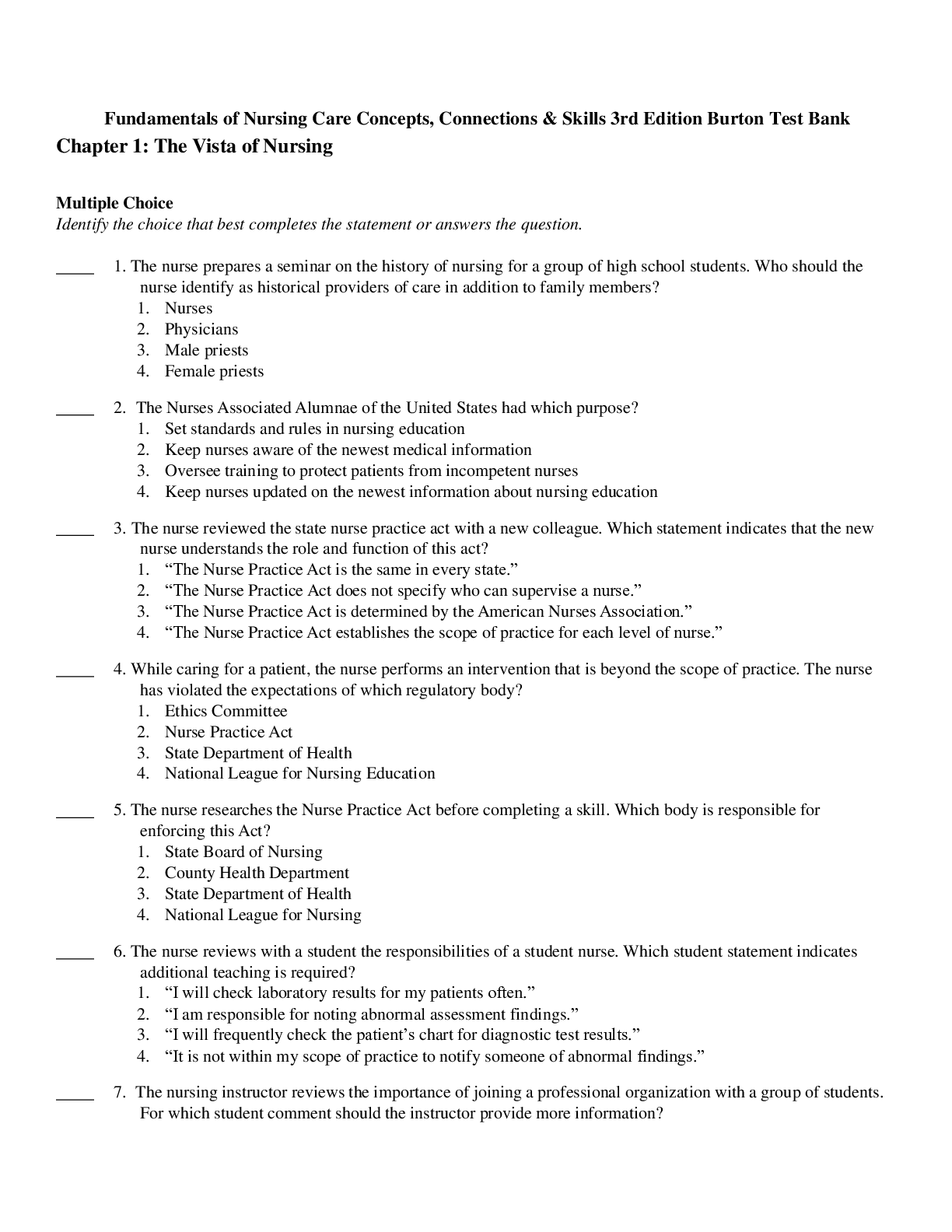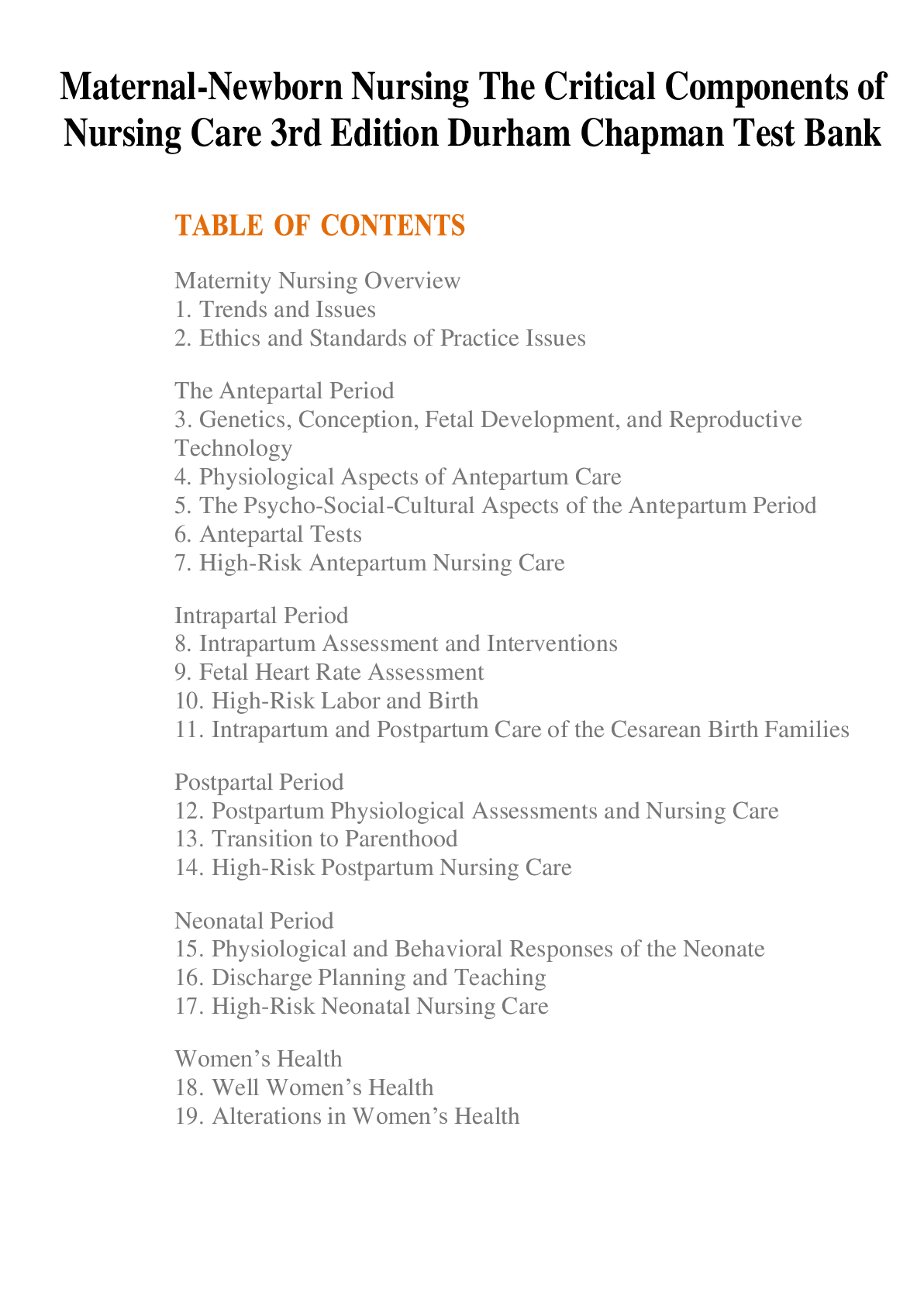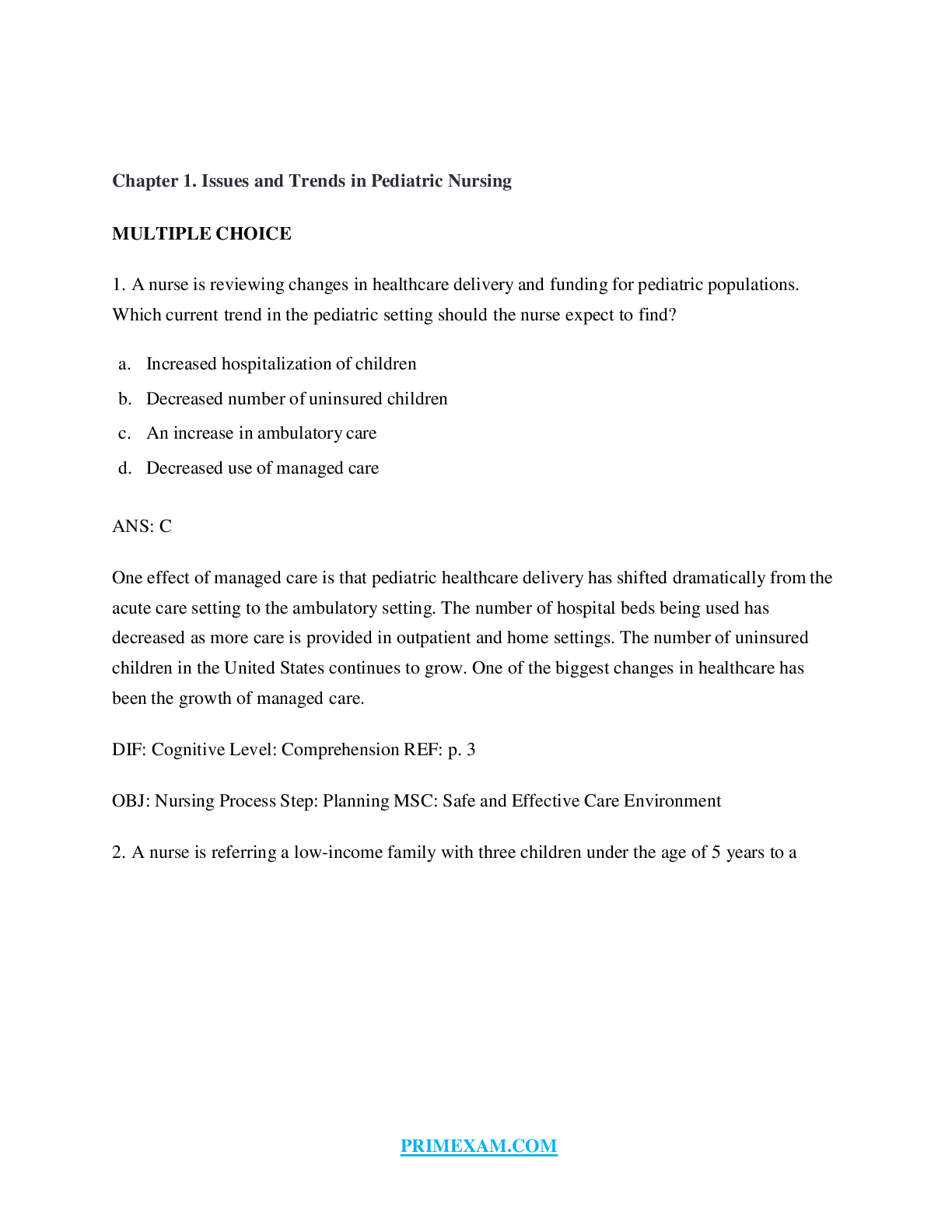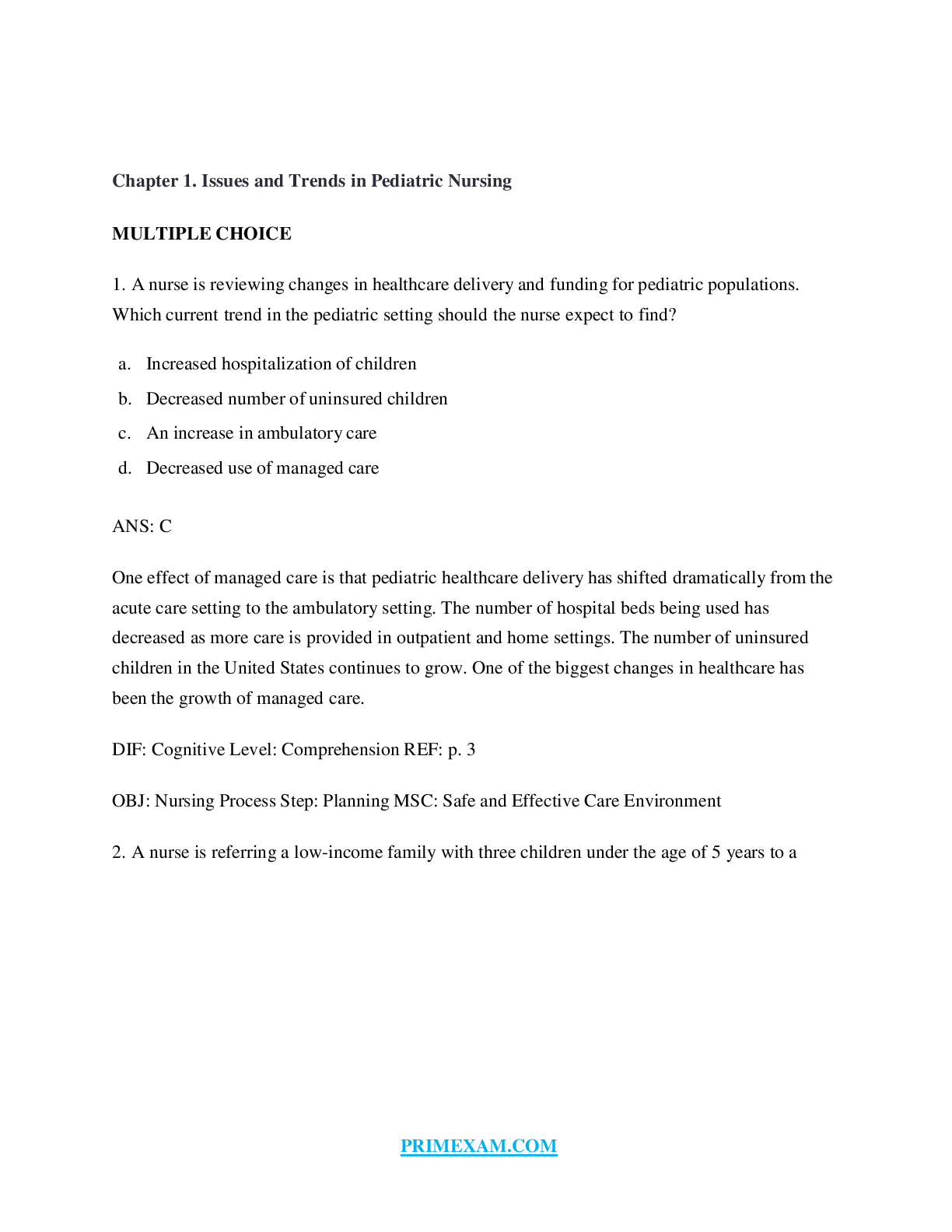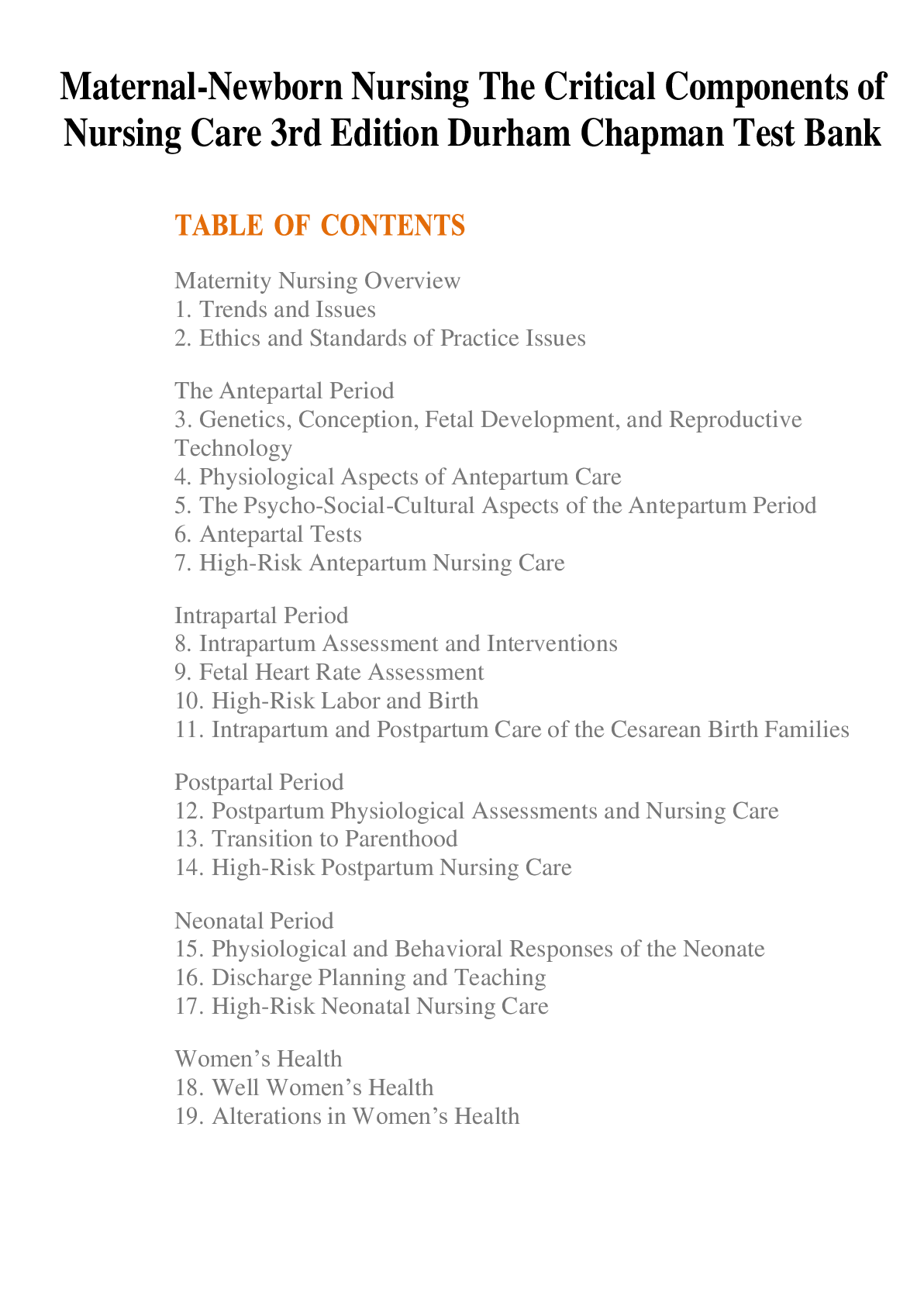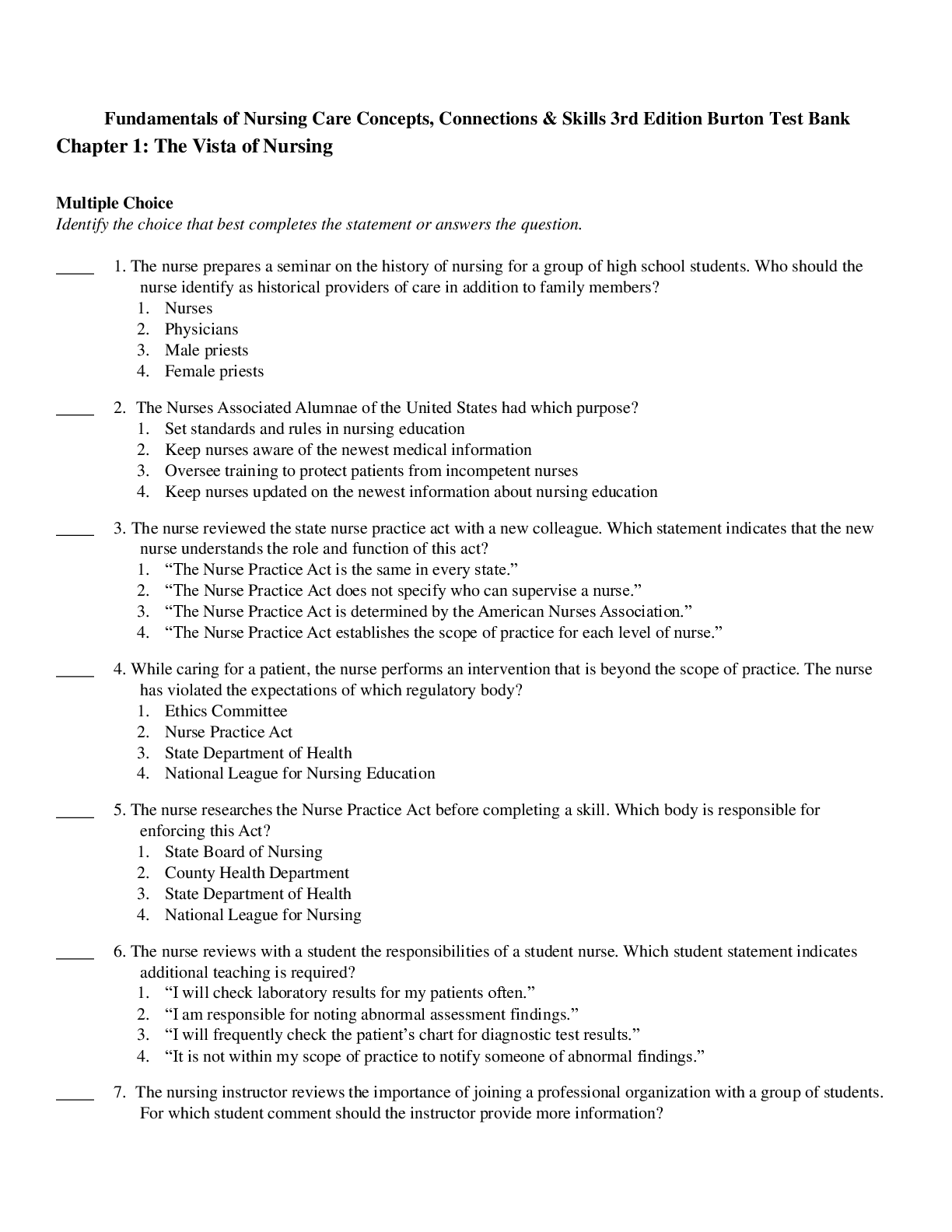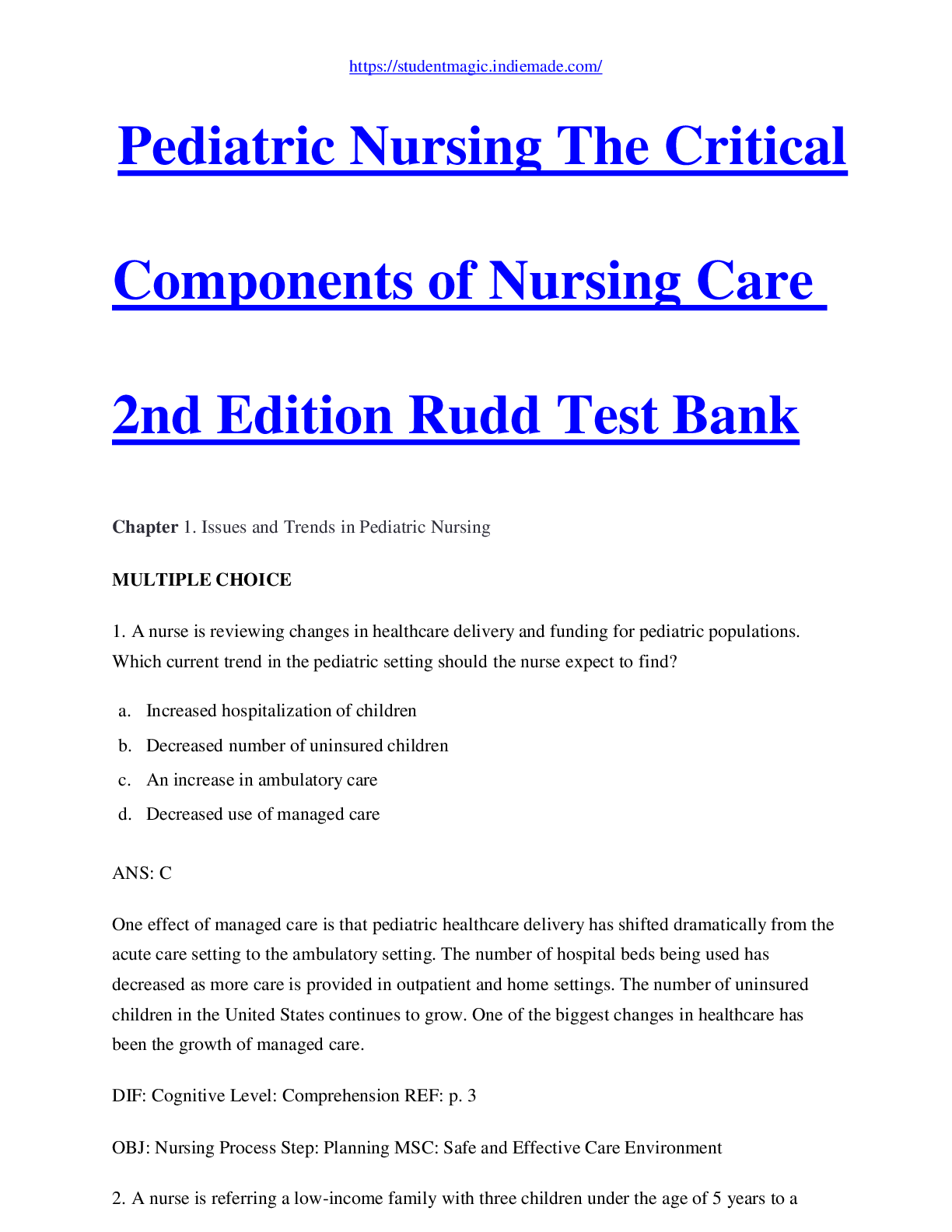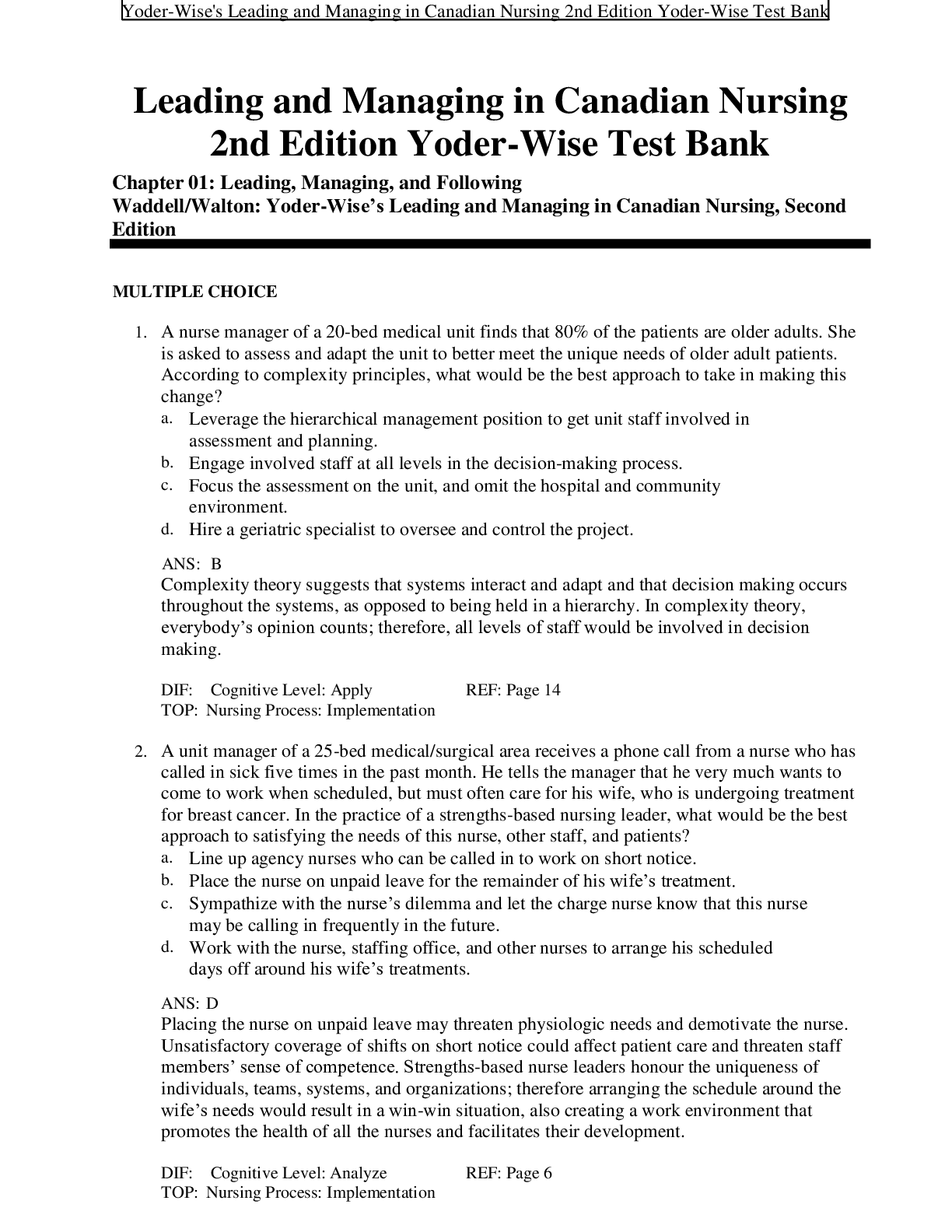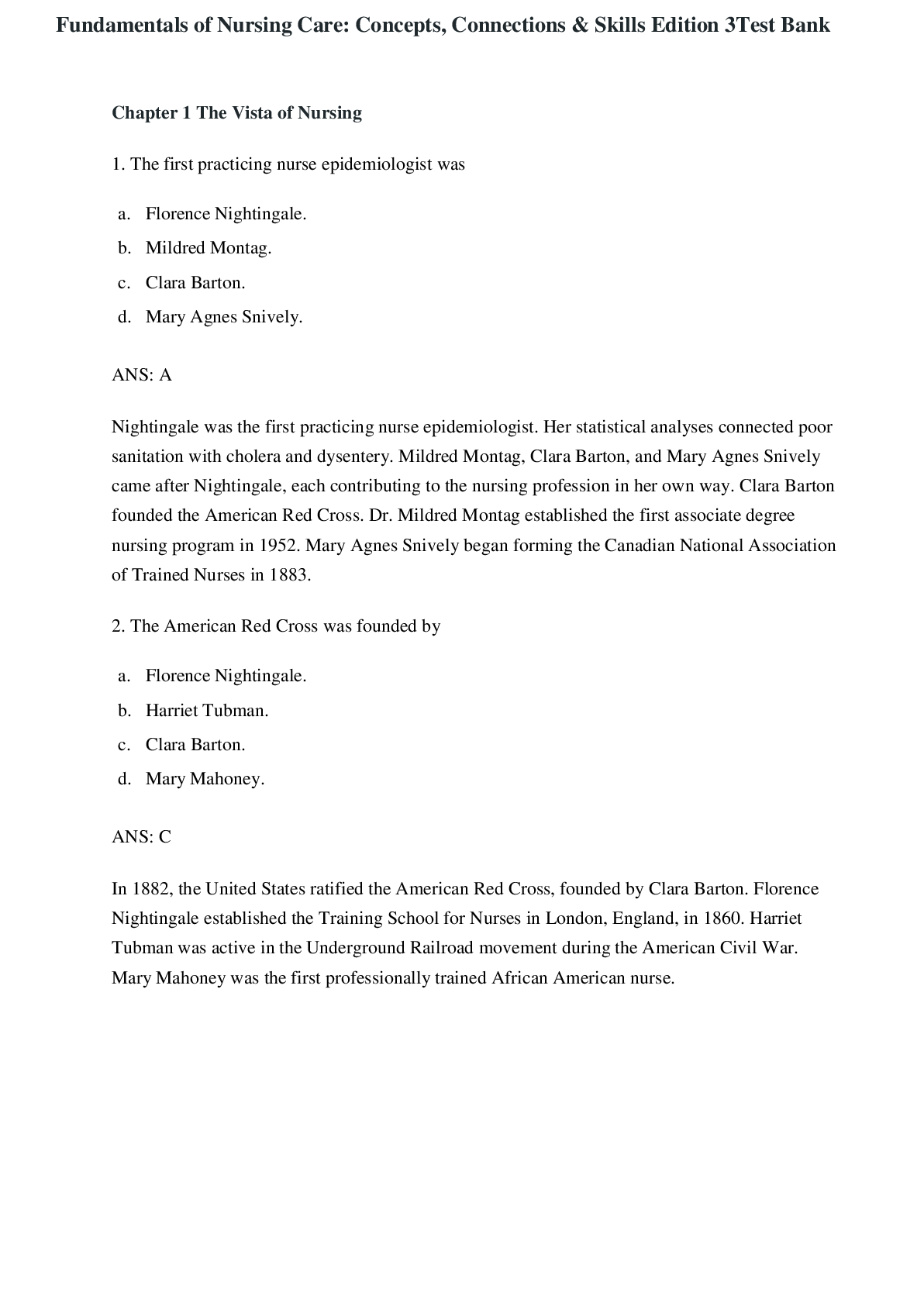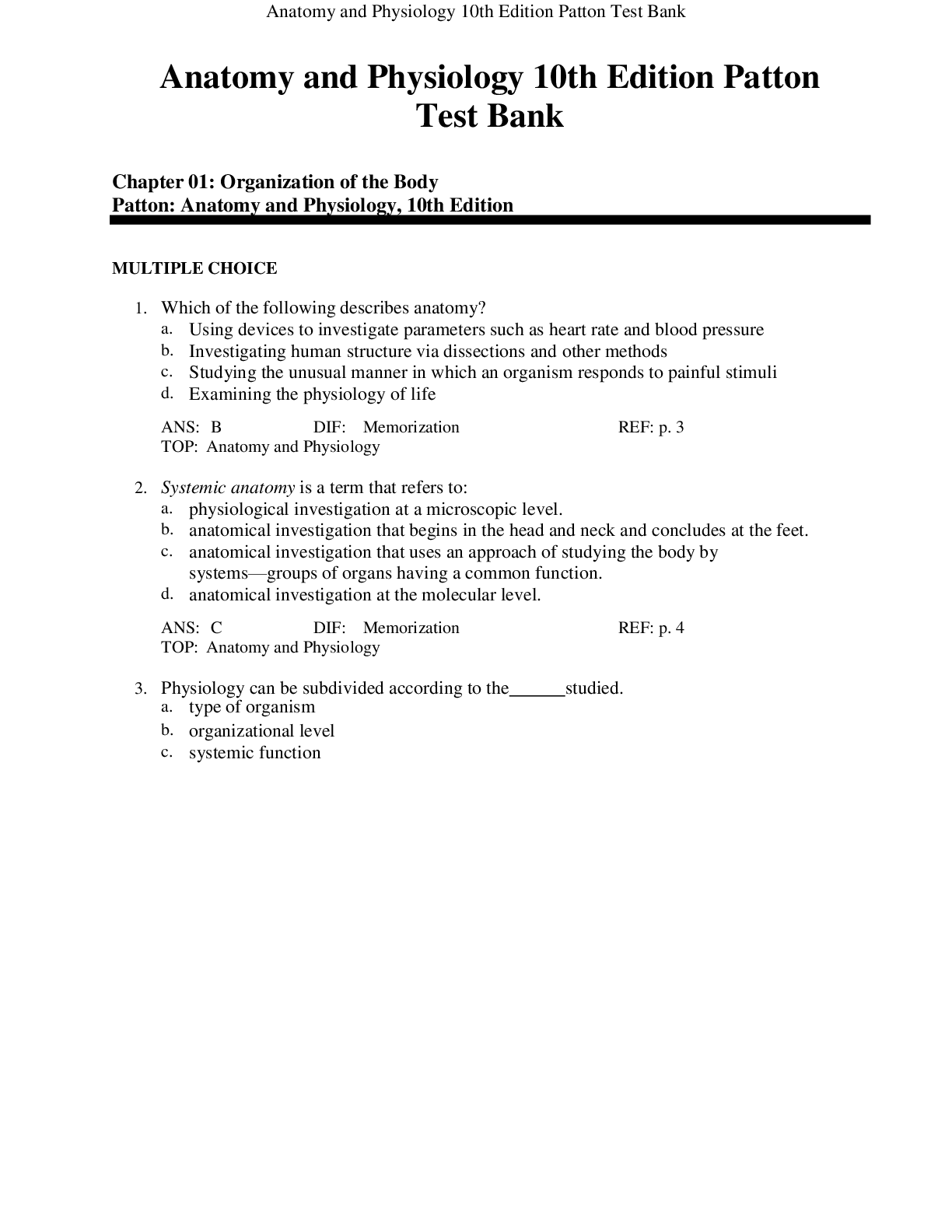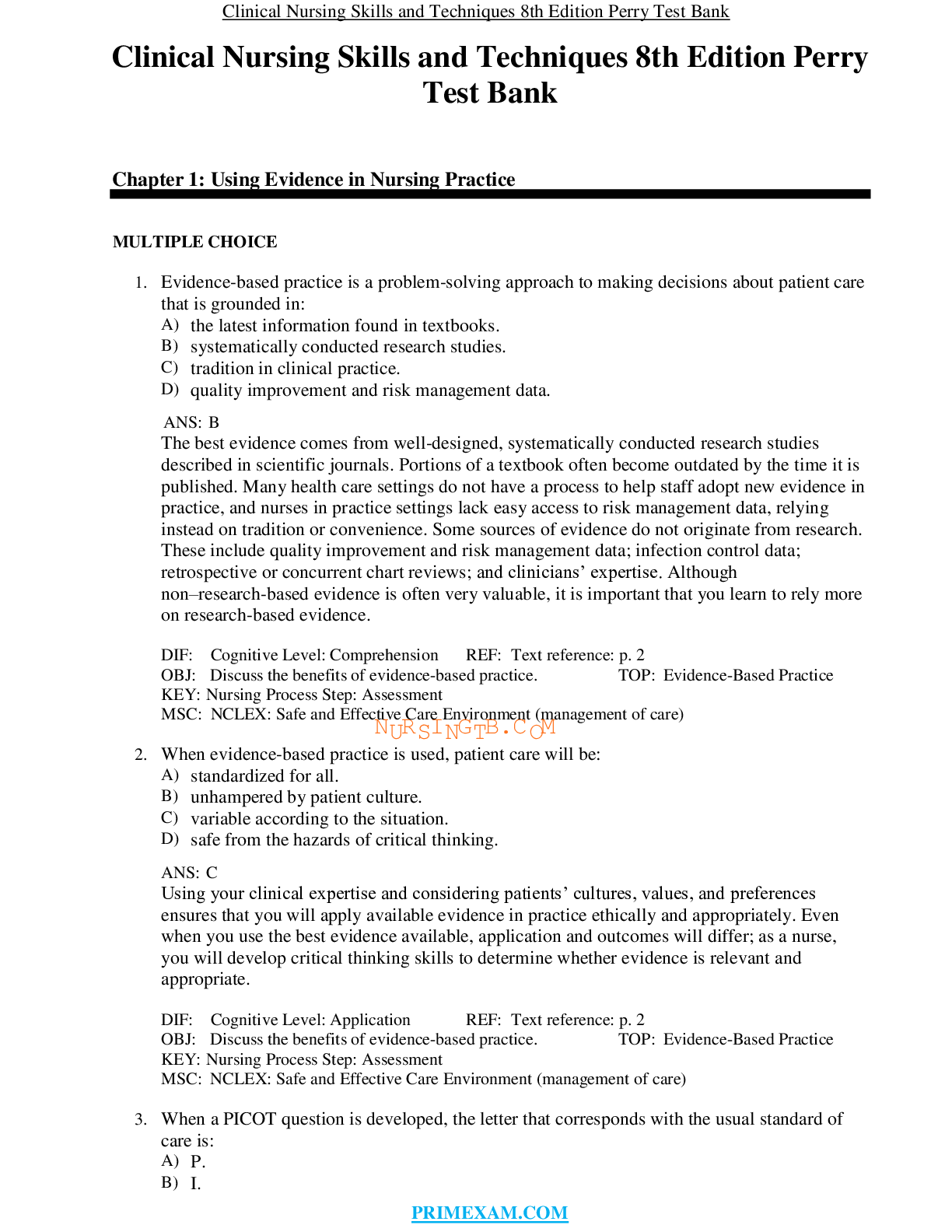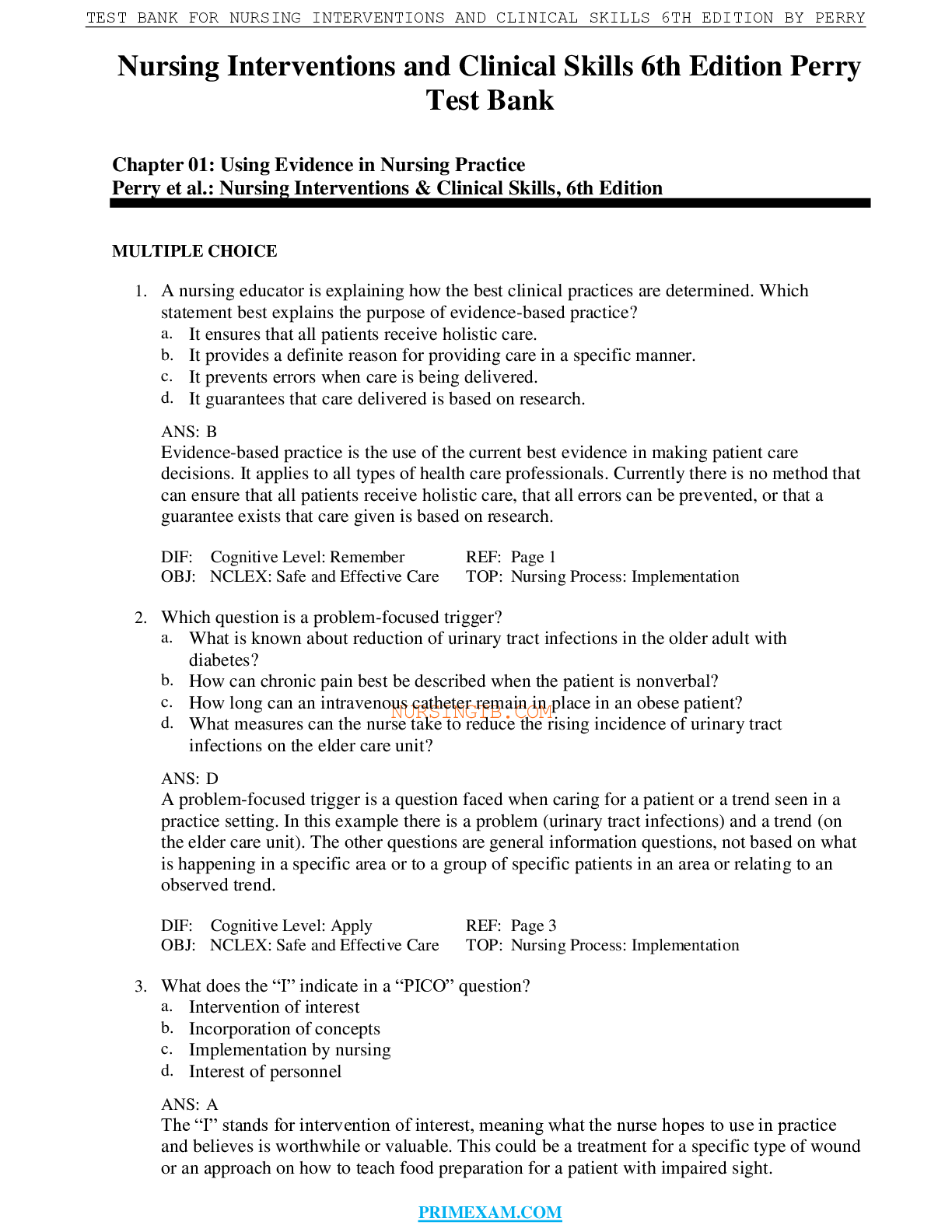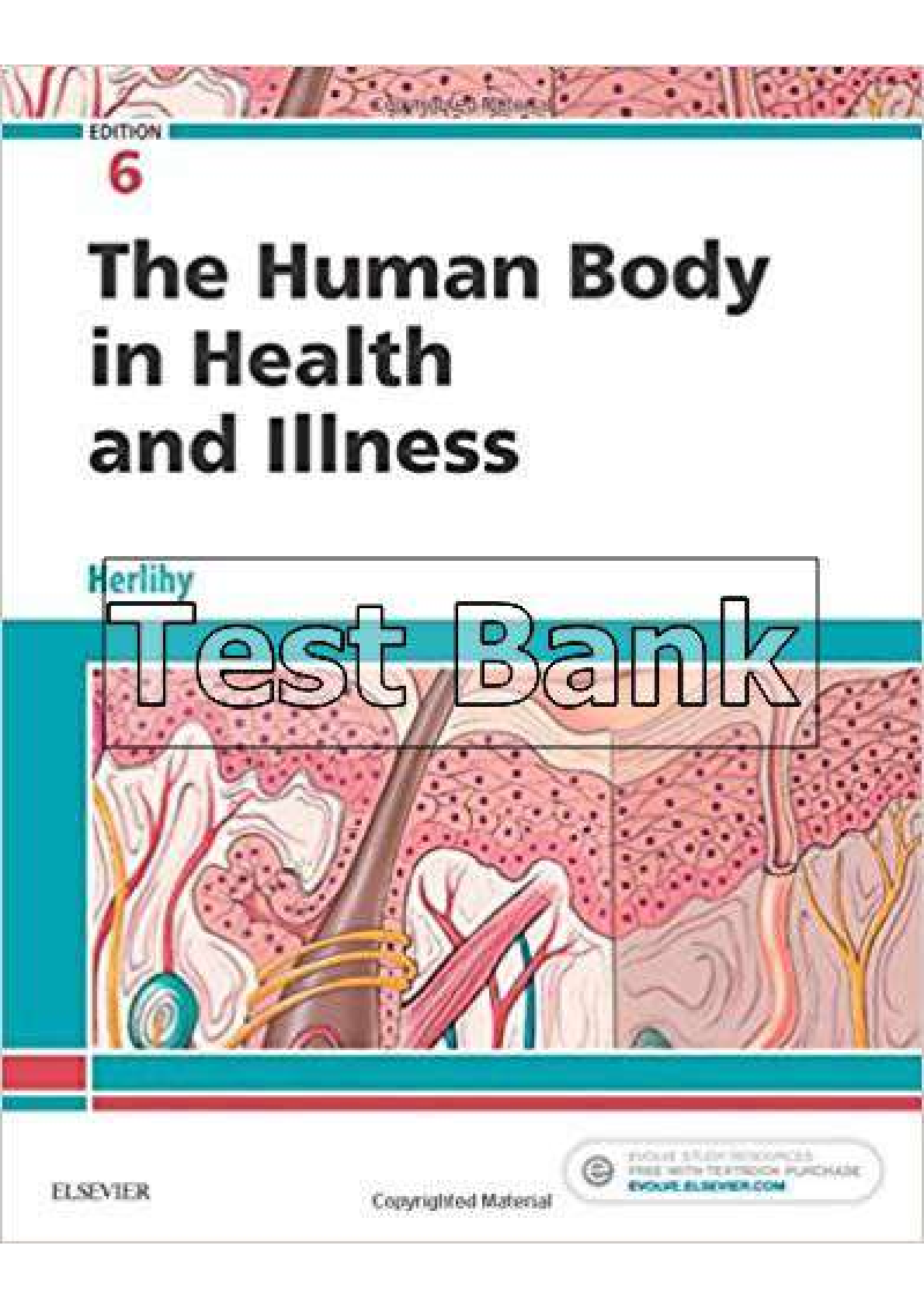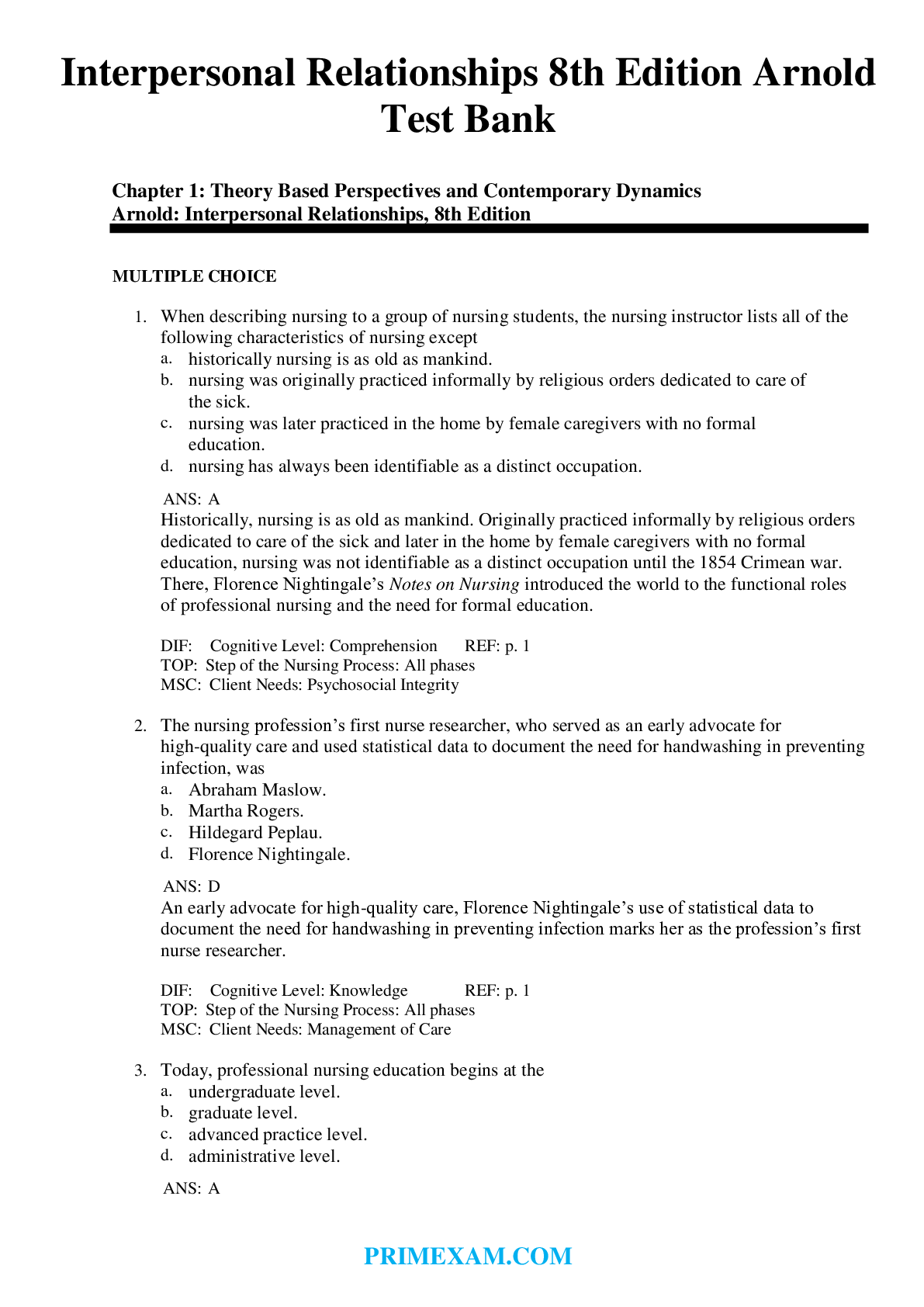*NURSING > TEST BANK > Pediatric Nursing The Critical Components of Nursing Care 2nd Edition Rudd Test Bank ( CONTAINS ALL (All)
Pediatric Nursing The Critical Components of Nursing Care 2nd Edition Rudd Test Bank ( CONTAINS ALL CHAPTERS, ALL ANSWERS 100% CORRECT) PURCHASE TO SCORE A+, GUARANTEED GRADES
Document Content and Description Below
Pediatric Nursing The Critical Components of Nursing Care 2nd Edition Rudd Test Bank Chapter 1. Issues and Trends in Pediatric Nursing MULTIPLE CHOICE 1. A nurse is reviewing changes in healthcare... delivery and funding for pediatric populations. Which current trend in the pediatric setting should the nurse expect to find? a. Increased hospitalization of children b. Decreased number of uninsured children c. An increase in ambulatory care d. Decreased use of managed care ANS: C One effect of managed care is that pediatric healthcare delivery has shifted dramatically from the acute care setting to the ambulatory setting. The number of hospital beds being used has decreased as more care is provided in outpatient and home settings. The number of uninsured children in the United States continues to grow. One of the biggest changes in healthcare has been the growth of managed care. DIF: Cognitive Level: Comprehension REF: p. 3 OBJ: Nursing Process Step: Planning MSC: Safe and Effective Care Environment 2. A nurse is referring a low-income family with three children under the age of 5 years to a program that assists with supplemental food supplies. Which program should the nurse refer this family to? a. Medicaid b. Medicare c. Early and Periodic Screening, Diagnostic, and Treatment (EPSDT) program d. Women, Infants, and Children (WIC) program ANS: D WIC is a federal program that provides supplemental food supplies to low-income women who are pregnant or breast-feeding and to their children until the age of 5 years. Medicaid and the Medicaid Early and Periodic Screening, Diagnostic, and Treatment (EPSDT) program provides for well-child examinations and related treatment of medical problems. Children in the WIC program are often referred for immunizations, but that is not the primary focus of the program. Public Law 99-457 provides financial incentives to states to establish comprehensive early intervention services for infants and toddlers with, or at risk for, developmental disabilities. Medicare is the program for Senior Citizens. DIF: Cognitive Level: Application REF: p. 7 OBJ: Nursing Process Step: Implementation MSC: Health Promotion and Maintenance 3. In most states, adolescents who are not emancipated minors must have parental permission before: a. treatment for drug abuse. b. treatment for sexually transmitted diseases (STDs). c. obtaining birth control. d. surgery. ANS: D An emancipated minor is a minor child who has the legal competence of an adult. Legal counsel may be consulted to verify the status of the emancipated minor for consent purposes. Most states allow minors to obtain treatment for drug or alcohol abuse and STDs and allow access to birth control without parental consent. DIF: Cognitive Level: Application REF: p. 12 OBJ: Nursing Process Step: Planning MSC: Safe and Effective Care Environment 4. A nurse is completing a clinical pathway for a child admitted to the hospital with pneumonia. Which characteristic of a clinical pathway is correct? a. Developed and implemented by nurses b. Used primarily in the pediatric setting c. Specific time lines for sequencing interventions d. One of the steps in the nursing process ANS: C Clinical pathways measure outcomes of client care and are developed by multiple healthcare professionals. Each pathway outlines specific time lines for sequencing interventions and reflects interdisciplinary interventions. Clinical pathways are used in multiple settings and for clients throughout the life span. The steps of the nursing process are assessment, diagnosis, planning, implementation, and evaluation. DIF: Cognitive Level: Comprehension REF: p. 6 OBJ: Nursing Process Step: Planning MSC: Safe and Effective Care Environment 5. When planning a parenting class, the nurse should explain that the leading cause of death in children 1 to 4 years of age in the United States is: a. premature birth. b. congenital anomalies. c. accidental death. d. respiratory tract illness. ANS: C Accidents are the leading cause of death in children ages 1 to 19 years. Disorders of short gestation and unspecified low birth weight make up one of the leading causes of death in neonates. One of the leading causes of infant death after the first month of life is congenital anomalies. Respiratory tract illnesses are a major cause of morbidity in children. DIF: Cognitive Level: Application REF: p. 9 OBJ: Nursing Process Step: Implementation MSC: Safe and Effective Care Environment 6. Which statement is true regarding the quality assurance or incident report? a. The report assures the legal department that there is no problem. b. Reports are a permanent part of the clients chart. c. The nurses notes should contain the following: Incident report filed and copy placed in chart. d. This report is a form of documentation of an event that may result in legal action. ANS: D An incident report is a warning to the legal department to be prepared for potential legal action; it is not a part of the clients chart or nurse documentation. DIF: Cognitive Level: Knowledge REF: p. 14 OBJ: Nursing Process Step: Implementation MSC: Safe and Effective Care Environment 7. Which client situation fails to meet the first requirement of informed consent? a. The parent does not understand the physicians explanations. b. The physician gives the parent only a partial list of possible side effects and complications. c. No parent is available and the physician asks the adolescent to sign the consent form. d. The infants teenage mother signs a consent form because her parent tells her to. ANS: C The first requirement of informed consent is that the person giving consent must be competent. Minors are not allowed to give consent. An understanding of information, full disclosure, and voluntary consent are requirements of informed consent, but none of these is the first requirement. DIF: Cognitive Level: Comprehension REF: p. 12 OBJ: Nursing Process Step: Implementation MSC: Safe and Effective Care Environment 8. A nurse assigned to a child does not know how to perform a treatment that has been prescribed for the child. What should the nurses first action be? a. Delay the treatment until another nurse can do it. b. Make the childs parents aware of the situation. c. Inform the nursing supervisor of the problem. d. Arrange to have the child transferred to another unit. ANS: C If a nurse is not competent to perform a particular nursing task, the nurse must immediately communicate this fact to the nursing supervisor or physician. The nurse could endanger the child by delaying the intervention until another nurse is available. Telling the childs parents would most likely increase their anxiety and will not resolve the difficulty. Transfer to another unit delays needed treatment and would create unnecessary disruption for the child and family. DIF: Cognitive Level: Application REF: p. 11 OBJ: Nursing Process Step: Implementation MSC: Safe and Effective Care Environment 9. A nurse is completing a care plan for a child and is finishing the assessment phase. Which activity is not part of a nursing assessment? a. Writing nursing diagnoses b. Reviewing diagnostic reports c. Collecting data d. Setting priorities ANS: D Setting priorities is a part of planning. Writing nursing diagnoses, reviewing diagnostic reports, and collecting data are parts of assessment. DIF: Cognitive Level: Comprehension REF: p. 19 OBJ: Nursing Process Step: Planning MSC: Physiological Integrity 10. Which patient outcome is stated correctly? a. The child will administer his insulin injection before breakfast on 10/31. b. The child will accept the diagnosis of type 1 diabetes mellitus before discharge. c. The parents will understand how to determine the childs daily insulin dosage. d. The nurse will monitor blood glucose levels before meals and at bedtime. ANS: A The outcome is stated in client terms, with a measurable verb and a time frame for action. The verb accept is difficult to measure. The goal of accepting a diagnosis before hospital discharge is unrealistic. Outcomes should be stated in client terms. Nursing actions are determined after outcomes are developed in the implementation phase of the nursing process. DIF: Cognitive Level: Application REF: p. 20 OBJ: Nursing Process Step: Planning MSC: Safe and Effective Care Environment MULTIPLE RESPONSE 1. A nurse is reviewing the nursing care plan for a hospitalized child. Which statements are collaborative problems? Select all that apply. a. Risk for injury b. Potential complication of seizure disorder c. Altered nutrition: Less than body requirements d. Fluid volume deficit e. Potential complication of respiratory acidosis ANS: B, E In addition to nursing diagnoses, which describe problems that respond to independent nursing functions, nurses must also deal with problems that are beyond the scope of independent nursing practice. These are sometimes termed collaborative problemsphysiological complications that usually occur in association with a specific pathological condition or treatment. The potential complications of seizure disorder and respiratory acidosis are physiological complications that will require physician collaboration to treat. Risk for injury, altered nutrition, and fluid volume deficit will respond to independent nursing functions. DIF: Cognitive Level: Application REF: p. 20 OBJ: Nursing Process Step: Planning MSC: Safe and Effective Care Environment 2. Which nursing activities do not meet the standard of care? Select all that apply. a. Failure to notify a physician about a childs worsening condition b. Calling the supervisor about staffing concerns c. Delegating assessment of a new admit to the Unlicensed Assistive Personnel (UAP) d. Asking the Unlicensed Assistive Personnel (UAP) to take vital signs e. Documenting that a physician was unavailable and the nursing supervisor was notified ANS: A, C A nurse who fails to notify a physician about a childs worsening condition and delegating the assessment of a new admit to a UAP do not meet the standard of care. Calling the supervisor about staffing concerns, asking the UAP to take vital signs, and documenting that a physician could not be reached and the nursing supervisor was notified all meet the standard of care. Chapter 2. Standards of Practice and Ethical Considerations Multiple Choice 1. Leah is a new graduate nurse and has questions about her scope of practice. The best place to review would be: 1. The code of ethics. 2. The standards of practice and professional performance. 3. The NCLEX exam. 4. The state licensing body. ANS: 2 Feedback 1.Applies to the accountability and protection for the public 2.Benchmark for quality and accountability to provide professional guidance 3.This is the basic exam, but it does not give guidance on this matter. 4.The state has rules and regulations, but it is not the source for overall professional accountability and guidance. 2. The Code of Ethics for Nurses is characterized by all of the following except: 1. It serves as a guide to empower individuals. 2. It upholds ethics, principles, rights, duties and virtues. 3. It is a private statement for nurses only. 4. It is a public statement for nurses and their patients. ANS: 3 Feedback 1.Part of the Code of Ethics 2.Part of the Code of Ethics 3. The Code of Ethics is not a private statement. It is for the public and nurses. 4. Part of the Code of Ethics 3. A nurse has discussed the plan of care, asked for parental input, and has spoken with the doctor about the needs of the family and patient. This nurse is exhibiting which characteristics of therapeutic relationships in pediatric medicine? 1. Goals, mutual respect/trust, and advocacy 2. Empowerment, sympathy, and empathy 3. Goals, advocacy, and sympathy 4. Respect/trust, disengagement, and sympathy ANS: 1 Feedback 1. The nurse is demonstrating all characteristics listed. 2. The nurse is not demonstrating sympathy or empathy for the patient. 3.The nurse is not demonstrating sympathy for this family. 4.The nurse is not disengaging or providing sympathy for the family. 4. A primary source for the standards of practice for pediatric nurses is: 1. Pediatric Nursing Scope and Standards of Practice. 2. Code of Ethics. 3. Nightingales Pledge. 4. None of the above. ANS: 1 Feedback 1. Reflects key themes and trends that are relevant to our time and to all pediatric health care settings, which provide the framework for the emergence of specific standards. 2. The Code of Ethics in Nursing provides a foundation for nurses and empowers them as well. 3. The pledge was part of the early Hippocratic Oath. 4.One answer is correct. 5. Sarah is a 4-year-old patient with cystic fibrosis. She has been having increased hospitalizations and prefers to have Leah as her nurse as an inpatient. Leah has been assigned to care for a different set of patients today, yet Sarahs mother insists on having Leah as their nurse. Which action would be best for Leah to take with Sarah and her mother? 1. Ignore the situation. 2. Speak to Sarah and her mother to discuss the importance of having another nurse, who also knows the case, care for her. 3. Let Sarahs mother and Sarah voice their reasoning for wanting Leah, and then explain the need for Leah to have a different assignment. 4. Let the charge nurse deal with the situation. ANS: 3 Feedback 1.Ignoring the situation does not demonstrate therapeutic communication. 2.Speaking with the family is important, but letting the family voice their concerns is important as well. 3. The dialogue between the patient and nurse can enhance trust and understanding so the patient can understand the situation. 4. The charge nurse may be part of the conversation, but it is important for Leah to speak too. 6. Which of the following situations would be considered a therapeutic communication challenge in pediatric nursing? 1. 1. A street-smart teenager 2. 2. A noncompliant patient and family 3. 3. A culture that the nurse has not been previously exposed to 4. 4. All of the above ANS: 4 Feedback 1.Considered a therapeutic communication challenge in pediatric nursing 2.Considered a therapeutic communication challenge in pediatric nursing 3.Considered a therapeutic communication challenge in pediatric nursing 4.All fit the criteria 7. The purpose of a Child Life Department for Family-Centered Care is: 1. To prepare the child for procedures. 2. To offer time to be a kid. 3. To provide the staff with information about child development. 4. To be the liaison between the hospital and the school system for a child. 5. 1, 2, 4 ANS: 5 Feedback 1. Preparation is an important element in caring for a child. It helps reduce anxiety and promotes a trusting relationship. 2. Playtime allows a child to cope and fosters self-expression, which reduces stress. 3. CLD is knowledgeable in child development and is present to support the child and the family, not the staff. 4. CLD provides a working relationship between the hospital and school for patients who are in the hospital long term. 5. Preparation is an important element in caring for a child. It helps reduce anxiety and promotes a trusting relationship. Playtime allows a child to cope and fosters self-expression, which reduces stress. CLD provides a working relationship between the hospital and school for patients who are in the hospital long term. 8. A nurse is discussing pain management of a 3 year-old with the parents. An important factor the nurse should mention is: 1. A child is like a mini-adult, so they cope with pain the same way. 2. Effective pain management for a child may require pharmacological and non-pharmacological methods. 3. Children use the pain scale of 0-10. 4. Pain is subjective, and all children cry when they are in pain. ANS: 2 Feedback 1. Children have a unique response to pain. 2. Pharmacological methods may work for children, but using non- pharmacological methods, such as distraction, are also beneficial. 3. Common pain scales for children consist of the FLACC and NAP. 4.Pain is subjective, but not all children will cry. Some will be irritable or withdrawn. 9. A 6-year-old boy is to receive a dose of morphine to aid in pain management after an open appendectomy. The nurse knows the correct dose for the morphine is calculated based on: 1. Age. 2. Height. 3. Body weight. 4. All of the above. ANS: 3 Feedback 1. Age is not a factor in drug calculation. 2. Height is not a factor in drug calculation. 3. Body weight is used for drug calculation. 4. Age and height do not affect drug calculation. 10. A nurse at the clinic is teaching a new mother how to give Tylenol drops to her infant. The nurse knows that the mother has an understanding of medication administration when the mother states: 1. I will give the medication as prescribed and use a teaspoon to measure the correct amount. 2. I will use a syringe to measure the correct amount and place the syringe in the side of his cheek to take the medicine. 3. I will measure the medication in a cup and place it into the bottle. 4. I will make sure he only takes the medicine until he acts like he feels better. ANS: 2 Feedback 1.A teaspoon does not give an accurate measurement for childrens medication. 2.A syringe is the best option for medication administration. Placing it in the side of the cheek enables the infant to swallow without choking. 3. This method does not ensure that the child received all the medication, especially if the entire bottle is not consumed. 4. Medication should be taken for as long as the doctor has ordered. 11. The public health nurse is working on new printed material for the pediatric clinic. The public health nurse decides more education needs to be provided on nutritious snacks for children 5 to 10 years of age. In the design process of the pamphlets, it is important for the public health nurse to: 1. Provide information at an educational level no higher than 8th grade. 2. Provide information at an education level no higher than 12th grade. 3. Provide the material in an easy manner, using acronyms to keep the pamphlet small. 4. Provide information in small print and place the pamphlet in open areas for people to take freely. ANS: 1 Feedback 1.Information should be at the 8th grade level or lower. 2.Information should be at 8th grade level or lower. 3.Acronyms may give different ideas than what the material is stating. 4.Allowing for people to take freely is good, but small print can deter someone from reading the information. Bold and bright print is best. 12. A pediatric clinic nurses main responsibilities include: 1. Assessing parenting styles. 2. Assessing readiness to learn for the patient and family. 3. Documentation of family and parental responses to education. 4. Assessing the culture of the family. 5. All of the above. 6. None of the above. ANS: 5 Feedback 1. It is a responsibility along with others. 2. It is a responsibility along with others. 3. It is a responsibility along with others. 4. It is a responsibility along with others. 5. Correct because all are responsibilities of the nurse. 6. One answer is correct. 13. Grant, who is 16, is at the pediatric clinic for his yearly checkup. The nurse requests that his father step out of the patient room because: 1. Grants father is not providing information the nurse needs. 2. Grant appears apprehensive with his father in the room. 3. Grant has a right to confidentiality to discuss his use of alcohol. 4. Privacy is not appropriate for this age range, and the father should remain in the room. ANS: 3 Feedback 1. Confidentiality is appropriate due to Grants age. 2. The question does not give information about the interaction between Grant and his father. 3. Privacy about topics such as substance use is appropriate for this age range. 4. Grant has a right to confidentiality due to his age. 14. A medical chaperone is advisable for a 14-year-old girl when: 1. Having an exam of the breasts. 2. Having an eye exam. 3. Having a hearing screen. 4. Having her height and weight taken. ANS: 1 Feedback 1.A medical chaperone should be present because of the invasiveness of the procedure. 2.A medical chaperone is recommended, but not a necessity. 3.A medical chaperone is recommended, but not a necessity. 4.A medical chaperone is recommended, but not a necessity. 15. A 9-year-old has come to the nurses office at the school complaining of arm pain. The nurse examines the arm and notices fingertip bruises on the forearm, as if it has been squeezed tightly. The nurse talks to the child about how the arm got the bruises. The next action the school nurse should take is: 1. Report this to the classroom teacher, principal, and Child Protective Services since it is a questionable mark on the forearm. 2. Let the child go back to the classroom since this is a normal bruising pattern that children get at this age through play. 3. Let the child go back to the classroom since the child explains that the bruises came from a game of tag. 4. Document the bruising and follow up with the child in two days to make sure it is healing. ANS: 1 Feedback 1. The nurse is a mandatory reporter and should speak with the people listed because bruising like this is abnormal for a child. 2. This is an abnormal bruising pattern for child. 3.Documentation and notification should occur because this is an abnormal bruising pattern for a child. 4.Documentation and notification should occur because this is an abnormal bruising pattern for a child. 16. Ali is a new graduate nurse and has been working on the nursing unit for six months. Ali has noticed that the nurses station attempts to keep patient information confidential. Which of the following actions are not good practices for maintaining confidentiality? 1. Placing the patient chart upside down on the desk when not in use so the name is not revealed. 2. Speaking of patients by room number, not by name. 3. Staying logged onto a computer to answer a call light. 4. Removing patient identifiers on a medication bottle and throwing it into the garbage can. ANS: 3 Feedback 1.This is a good practice for confidentiality. 2.This is a good practice for confidentiality. 3. This allows for anyone to see the computer information about a patient, thus breaking confidentiality. 4. This is a good practice for confidentiality. 17. HIPAA requires health-care providers and employees to be cognizant of: 1. Placement of computer screens to the public. 2. Where discussions about patients occur. 3. How and where change of shift reports occur. 4. All of the above are areas to keep confidential. ANS: 4 Feedback 1.Follows HIPAA confidentiality along with others. 2.Follows HIPAA confidentiality along with others. 3.Follows HIPAA confidentiality along with others. 4.Computer screens, discussions, and change of shift reports should be kept confidential to follow HIPAA guidelines. 18. Jake, a 14-year-old terminal leukemia patient, has told his parents and his health-care providers that he no longer wants to take chemotherapy treatments. The nurse knows that Jake: 1. Can make this decision because he is of legal medical age. 2. Is not of legal age to make a medical decision. This is an ethical decision that must be discussed only with Jakes parents. 3. Must discuss this ethical issue with his parents. 4. Is not of legal age to make a medical decision, thus he has not right to determine his care. ANS: 3 Feedback 1. Jake is not of legal age to make a medical decision, but he is of an age where he is aware of his body and the medical teams actions. 2. Jake should be a part of the discussion because he is at an age where he is aware of his body and medical needs. 3. Jake and his parents should make the decision together. 4. Jakes parents have medical power of attorney, but he is at an age where his wants and needs should be taken into consideration. 19. JoJo, a 10-year-old patient in room 1232 with a right arm and leg amputation due to osteosarcoma, has been refusing help with his daily routine. JoJo is exhibiting: 1. Beneficence. 2. Justice. 3. Veracity. 4. Autonomy. ANS: 4 Feedback 1. This is an act for a nurse to do good, not harm a patient. 2. This is the obligation for caring for the patient. 3. This is the act of telling the patient the truth. 4. This is an act of exhibiting the need to do things by oneself. 20. A home-care pediatric nurse is taking care of an immobile three year old with a home ventilator. The nurse knows she must maintain proper positioning for the child in order to prevent bedsores from developing. This knowledge is known as: 1. Justice. 2. Beneficence. 3. Veracity. 4. Fidelity. ANS: 2 Feedback 1. This is the obligation for caring for the patient. 2. This is an act for a nurse to do good, not harm a patient. 3.This is the act of telling the patient the truth. 4.This is a nurses responsibility for providing the best care possible for the patient. Chapter 3. Family Dynamics and Communicating with Children and Families MULTIPLE CHOICE 1. A nurse is teaching parents how to apply time-out as a disciplinary method for their 4 year old. Parents have understood the teaching if they state which formula correctly guides the use of time-out? a. Use the guideline of 1 minute per each year of the childs age. b. Relate the length of the time-out to the severity of the behavior. c. Never use time-out for a child younger than age 4 years. d. Follow the time-out with a treat. ANS: A In time-out, the child is told to sit on a chair for a predetermined time, usually 1 minute per year of age. Relating time to a behavior is subjective and inappropriate when the child is very young. Time-out can be used with a toddler. Negative behavior should not be reinforced with a positive action. DIF: Cognitive Level: Comprehension REF: p. 34 OBJ: Nursing Process Step: Evaluation MSC: Health Promotion and Maintenance 2. What is the nurses best approach when an 8-year-old boy frequently causes a disruption in the playroom by taking toys from other children? a. Exclude the child from the playroom. b. Explain to the children in the playroom that he is very ill and should be allowed to have the toys. c. Approach the child in his room and ask, Would you like it if the other children took your toys from you? d. Approach the child in his room and state, I am concerned that you are taking the other childrens toys. It upsets them and me. ANS: D The nurse can focus on the behavior most effectively by using I rather than you messages. A you message criticizes the child and uses guilt in an attempt to change behavior. Banning the child from the playroom will not solve the problem. The problem is the childs behavior, not the place where the child exhibits it. Illness is not a reason for a child to be undisciplined. When the child recovers, the parents will have to deal with a child who is undisciplined and unruly. The child should not be made to feel guilty and to have his or her self-esteem attacked. DIF: Cognitive Level: Application REF: p. 34 OBJ: Nursing Process Step: Implementation MSC: Psychosocial Integrity 3. Families that deal most effectively with stress have which behavior patterns? a. Focus on family problems. b. Feel weakened by stress. c. Expect that some stress is normal. d. Feel guilty when stress exists. ANS: C Healthy families recognize that some stress is normal in all families, focus on family strengths rather than on the problems, and know that stress is temporary and may be positive. Because some stress is normal in all families, there is no reason to feel guilty. Guilt only immobilizes the family and does not lead to a resolution of the stress. DIF: Cognitive Level: Comprehension REF: p. 25 OBJ: Nursing Process Step: Assessment MSC: Psychosocial Integrity 4. Which family will most likely have the greatest difficulty in coping with an ill child? a. A single-parent mother who has the support of her parents and siblings b. Parents who have just moved to the area and are living in an apartment while they look for a house c. The family of a child who has had multiple hospitalizations related to asthma and has adequate relationships with the nursing staff d. A family in which there is a young child and four older married children who live in the area ANS: B Parents who are in a new environment will have increased stress related to their lack of a support system. If only one parent is available but has the support of her extended family, this will assist in her adjustment to the crisis. The family that has had positive experiences in the past with hospitalizations can draw from those experiences and feel confident about the current setting. For the family with one younger child and four older married children who live in the area, the family has an extensive support system, which will assist the parents in adjusting to the crisis. DIF: Cognitive Level: Application REF: p. 27 OBJ: Nursing Process Step: Planning MSC: Psychosocial Integrity 5. Which is the priority nursing intervention for the family of a child who has been admitted to the hospital? a. Begin discharge teaching. b. Identify and mobilize internal and external strengths. c. Identify ways in which the family could have prevented their childs hospitalization. d. Instruct the parents on normal growth and development. ANS: B Family interventions should be directed toward enhancing positive coping strategies and directing the family to appropriate resources. Although discharge teaching is begun as soon as possible, it is ineffective if trust has not been established with the parents or if the level of stress precludes learning. By identifying weaknesses instead of focusing on strengths, the familys anxiety and feelings of powerlessness or guilt may increase. Normal growth and development should be interwoven into teaching; however, teaching cannot take place until the parents have less stress and are open to information. DIF: Cognitive Level: Application REF: p. 27 OBJ: Nursing Process Step: Implementation MSC: Psychosocial Integrity 6. A nurse is planning culturally competent care for a child of Hispanic descent. Which characteristic found in a Hispanic family should the nurse include in the plan of care? a. Stoicism b. Close extended family c. Docile children are considered weak d. Very interested in health-promoting lifestyles ANS: B Most Mexican-American families are very close and it is not unusual for children to be surrounded by parents, siblings, grandparents, and godparents. It is important to respect this cultural characteristic and to see it as a strength, not a weakness. Although stoicism may be present in any family, Mexican-American families tend to be more expressive. Considering docile children as weak is a characteristic of American Indians. Although there is a trend for everyone to embrace more health-promoting lifestyles, it is more prominent in Anglo- Americans. DIF: Cognitive Level: Application REF: p. 28 OBJ: Nursing Process Step: Planning MSC: Psychosocial Integrity 7. While reviewing nursing documentation on dietary intake for a 7-year-old child of Asian descent, the nurse notes that he consistently refuses to eat the food on his tray. Which assumption is most likely accurate? a. He is a picky eater. b. He needs less food because he is on bed rest. c. He may have culturally related food preferences. d. He is probably eating between meals and spoiling his appetite. ANS: C When cultural differences are noted, food preferences should always be obtained. A child will often not eat unfamiliar foods. Although the child may be a picky eater, the key point is that he is from a different culture. The foods he is being served may seem strange to him. Nutrition plays an important role in healing. Although the child expends less energy while on bed rest, he has increased needs for good nutrition. Although it should be determined whether the child is eating food the family has brought from home, it is more important to determine his food preferences. DIF: Cognitive Level: Application REF: p. 28 OBJ: Nursing Process Step: Assessment MSC: Psychosocial Integrity 8. To resolve family conflict, it is necessary to have open communication, accurate perception of the problem, and a(n): a. intact family structure. b. arbitrator. c. willingness to consider the view of others. d. balance in personality types. ANS: C Without the willingness of the members of a group to consider the views of others, conflict resolution cannot take place. The structure of a family may affect their dynamics, but it is still possible to resolve conflict without an intact family structure if all the ingredients of conflict resolution are present. Conflicts can be resolved without the assistance of an arbitrator. Most families have diverse personality types among their members. This may make conflict resolution more difficult; however, it should not impede it if the ingredients of conflict resolution are present. DIF: Cognitive Level: Knowledge REF: p. 27 OBJ: Nursing Process Step: Implementation MSC: Psychosocial Integrity 9. A nurse is planning a parenting class for expectant parents. Which statement is true about the characteristics of a healthy family? a. The parents and children have rigid assignments for all the family tasks. b. Young families assume total responsibility for the parenting tasks, refusing any assistance. c. The family is overwhelmed by the significant changes that occur as a result of childbirth. d. Adults agree on the majority of basic parenting principles. ANS: D A trait of a healthy family is that adults agree on the basic principles of parenting so that minimal discord exists. A significant stressor for families is lack of shared responsibility in the family. Lack of flexibility in parental tasks is likely to create stress and conflict. Admitting to and seeking help with problems, rather than refusing assistance, is a trait of a healthy family. Adjusting to the birth of a child is a significant change for a family. A sense of feeling overwhelmed by this change indicates that the family is not coping effectively. DIF: Cognitive Level: Comprehension REF: p. 25 OBJ: Nursing Process Step: Planning MSC: Psychosocial Integrity 10. A nurse determines that a child consistently displays predictable behavior and is regular in performing daily habits. Which temperament is the child displaying? a. Easy b. Slow-to-warm-up c. Difficult d. Shy ANS: A Children with an easy temperament are even tempered, predictable, and regular in their habits. They react positively to new stimuli. A high activity level and adapting slowly to new stimuli are characteristics of a difficult temperament. The slow-to-warm-up temperament type prefers to be inactive and moody. Shyness is a personality type and not a characteristic of temperament. Being moody is a characteristic of a slow-to-warm up temperament. DIF: Cognitive Level: Analysis REF: p. 33 OBJ: Nursing Process Step: Assessment MSC: Psychosocial Integrity 11. The parent of a child who has had numerous hospitalizations asks the nurse for advice because her child has been having behavior problems at home and in school. In discussing effective discipline, which is an essential component? a. All children display some degree of acting out and this behavior is normal. b. The child is manipulative and should have firmer limits set on her behavior. c. Use positive reinforcement and encouragement to promote cooperation and the desired behaviors. d. Underlying reasons for rules should be given and the child should be allowed to decide on which rules should be followed. ANS: C Using positive reinforcement and encouragement to promote cooperation and desired behaviors is one of the three essential components of effective discipline. Behavior problems should not be disregarded as normal. It would be incorrect to assume the child is being manipulative and should have firmer limits set on her behaviors. Providing the underlying reasons for rules and giving the child a choice concerning which rules to follow constitute a component of permissive parenting and are not considered an essential component of effective discipline. DIF: Cognitive Level: Comprehension REF: p. 33 OBJ: Nursing Process Step: Assessment MSC: Psychosocial Integrity 12. A nurse assesses that parents discuss rules with their children when the children do not agree with the rules. Which style of parenting is being displayed? a. Authoritarian b. Authoritative c. Permissive d. Disciplinarian ANS: B A parent who discusses the rules with which children do not agree is using an authoritative parenting style. A parent who expects children to follow rules without questioning is using an authoritarian parenting style. A parent who does not consistently enforce rules and allows the child to decide whether he or she wishes to follow rules is using a permissive parenting style. A disciplinarian style would be similar to the authoritarian style. 13. Which information should the nurse include when preparing a 5-year-old child for a cardiac catheterization? a. A detailed explanation of the procedure b. A description of what the child will feel and see during the procedure c. An explanation about the dye that will go directly into his vein d. An assurance to the child that he and the nurse can talk about the procedure when it is over ANS: B For a preschooler, the provision of sensory information about what to expect during the procedure will enhance the childs ability to cope with the events of the procedure and will decrease anxiety. Explaining the procedure in detail is probably more than the 5-year-old child can comprehend and it will produce anxiety. Using the word dye with a preschooler can be frightening for the child. The child needs information before the procedure. DIF: Cognitive Level: Application REF: pp. 44-45 OBJ: Nursing Process Step: Planning MSC: Health Promotion and Maintenance 14. Who are the experts in planning for the care of a 9-year-old child with a profound sensory impairment who is hospitalized for surgery? a. The childs parents b. The childs teacher c. The case manager d. The primary nurse ANS: A The parents, as primary caregivers, can identify the childs needs to help develop an effective, individualized plan of care. The childs teacher is not as expert as the childs parents for planning her care. The case manager is not as aware as the parents are of the childs individual needs. The primary nurse would use the childs parents as resources in planning the best approach to the childs care. DIF: Cognitive Level: Comprehension REF: p. 48 OBJ: Nursing Process Step: Planning MSC: Psychosocial Integrity 15. Which is an effective technique for communicating with toddlers? a. Have the toddler make up a story from a picture. b. Involve the toddler in dramatic play with dress-up clothing. c. Repeatedly read familiar stories to the child. d. Ask the toddler to draw pictures of his fears. ANS: C Ritualism is a characteristic of the toddler period. By repeating familiar stories and other rituals, the toddler feels a sense of control, which facilitates communication. Most toddlers do not have the vocabulary to make up stories. Dramatic play is associated with older children. Toddlers probably are not capable of drawing or verbally articulating their fears. DIF: Cognitive Level: Application REF: p. 44 OBJ: Nursing Process Step: Planning MSC: Health Promotion and Maintenance 16. What is the most important consideration for effectively communicating with a child? a. The childs chronological age b. The parentchild interaction c. The childs receptiveness d. The childs developmental level ANS: D The childs developmental level is the basis for selecting the terminology and structure of the message most likely to be understood by the child. The childs age may not correspond to the developmental level; therefore, it is not the most important consideration for communicating with children. Parentchild interaction is useful in planning communication with children, but it is not the primary factor in establishing effective communication. The childs receptiveness is a consideration in evaluating the effectiveness of communication. DIF: Cognitive Level: Comprehension REF: p. 43 OBJ: Nursing Process Step: Assessment MSC: Health Promotion and Maintenance 17. Which behavior is most likely to encourage open communication? a. Avoiding eye contact b. Folding arms across the chest c. Standing with head bowed d. Soft stance with arms loose at the side ANS: D A swaying body with arms loose at the sides suggests openness. Avoiding eye contact does not facilitate communication. Folding arms across the chest and standing with head bowed are closed-body postures, which do not facilitate communication. DIF: Cognitive Level: Comprehension REF: pp. 39-40 OBJ: Nursing Process Step: Implementation MSC: Psychosocial Integrity 18. Which strategy is most likely to encourage a child to express feelings about the hospital experience? a. Asking close-ended questions b. Asking direct questions c. Sharing personal experiences d. Actively listening ANS: D Active listening encourages conversation. Direct questions and close-ended questions can threaten and block communication. Talking about yourself shifts the focus of the conversation away from the child. DIF: Cognitive Level: Application REF: p. 38 OBJ: Nursing Process Step: Planning MSC: Psychosocial Integrity 19. Which is the most appropriate question to ask to encourage conversation when interviewing an adolescent? a. Are you in school? b. Are you doing well in school? c. How is school going for you? d. How do your parents feel about your grades? ANS: C Open-ended questions encourage communication. Direct questions with yes or no answers do not encourage conversation. Direct questions that can be interpreted as judgmental do not enhance communication. Asking adolescents about their parents feelings may block communication. DIF: Cognitive Level: Application REF: p. 45 OBJ: Nursing Process Step: Implementation MSC: Psychosocial Integrity 20. What is the most appropriate response for the nurse to make to the parent of a 3-year-old child found in a bed with the side rails down? a. You must never leave the child in the room alone with the side rails down. b. I am very concerned about your childs safety when you leave the side rails down. The hospital has guidelines stating that side rails need to be up if the child is in the bed. c. It is hospital policy that side rails need to be up if the child is in bed. d. When parents leave side rails down, they might be considered as uncaring. ANS: B To express concern and then choose words that convey a policy is appropriate. Framing the communication in the negative does not facilitate effective communication. Stating a policy to parents conveys the attitude that the hospital has authority over parents in matters concerning their children and may be perceived negatively. No statement should convey blame and judgment to the parent. Chapter 4. Cultural, Spiritual, and Environmental Influences on the Child Multiple Choice 1. Elsa is working with an 11-year-old patient in the outpatient pediatric clinic. As Elsa reviews the chart, she reads that the patient follows the Muslim tradition. When Elsa enters the room, she notes that the child is wearing a hijab on her head. Elsa has never worked with this tradition before. Elsa should: 1. Realize that her verbal and non-verbal communication will impact the care she gives the child. 2. Not ask the parent for input on the care of the child because this would disrespect the family and child. 3. Have another nurse, who has experience with this culture, take care of the patient. 4. Realize that the patient is uncomfortable and seek a fellow nurse to help her. ANS: 1 Feedback 1. Verbal and non-verbal communication differs in each culture, thus this must be taken into consideration when working with the child. 2. The lack of communication with the parent and child is not therapeutic for the child. 3. Another nurse may be beneficial, but since Elsa has already started caring for the child, this may create problems. 4. There is no indication of the patient feeling uncomfortable. 2. A pediatric nursing class has been assigned to use the Giger and Davidhizar Transcultural Assessment Model. The students are assigned to families they do not have a prior relationship with. When performing the assessment, one of the students is given a seat in close proximity to a grandmother on the couch. The student should know that according to this model: 1. Visiting a family is considered a privilege. 2. It is important to identify the family lifestyle. 3. Sitting close to the grandmother can affect the communication. 4. Only the interpersonal relationships of the individuals are emphasized. ANS: 3 Feedback 1. Does not address the economic standing of the family 2. Does not identify a lifestyle 3. Space is a component of the model. 4. Views the familys interactions with society 3. A staff educational day has been planned for the pediatric unit of a major hospital. The goal is to make the staff culturally competent. This is important because: 1. This competency meets JCAHO requirements. 2. This competency meets cultural care requirements for the hospital system. 3. This allows nurses to tailor their care to the patient and provide holistic care. 4. This education is needed to reach Magnet status. ANS: 3 Feedback 1. Not the purpose of the goal 2. Can be a purpose of the hospital, but does not take precedence over the patient. 3. Important to view the patient holistically in order to provide quality care 4.Not the purpose of the goal 4. Hussains parents have a language barrier with the nursing staff on the pediatric floor. When working with communication barriers, it is important to: 1. Use pictures when an interpreter is not available. 2. Use hand gestures to attempt to communicate. 3. Ask the interpreter to speak to the family over the phone. 4. Require the family to provide a family member to interpret. ANS: 1 Feedback 1.This is appropriate if there are pictures for the conversation. 2.Each culture is sensitive to body language. Avoid using gestures because this may offend the family. 3. Speaking over the phone can cause communication breakdown, which will not be effective for the conversation. 4. It is a responsibility of the hospital to provide an interpreter for the patient. [Show More]
Last updated: 1 year ago
Preview 1 out of 304 pages
Instant download

Instant download
Reviews( 0 )
Document information
Connected school, study & course
About the document
Uploaded On
Jul 16, 2021
Number of pages
304
Written in
Additional information
This document has been written for:
Uploaded
Jul 16, 2021
Downloads
0
Views
255


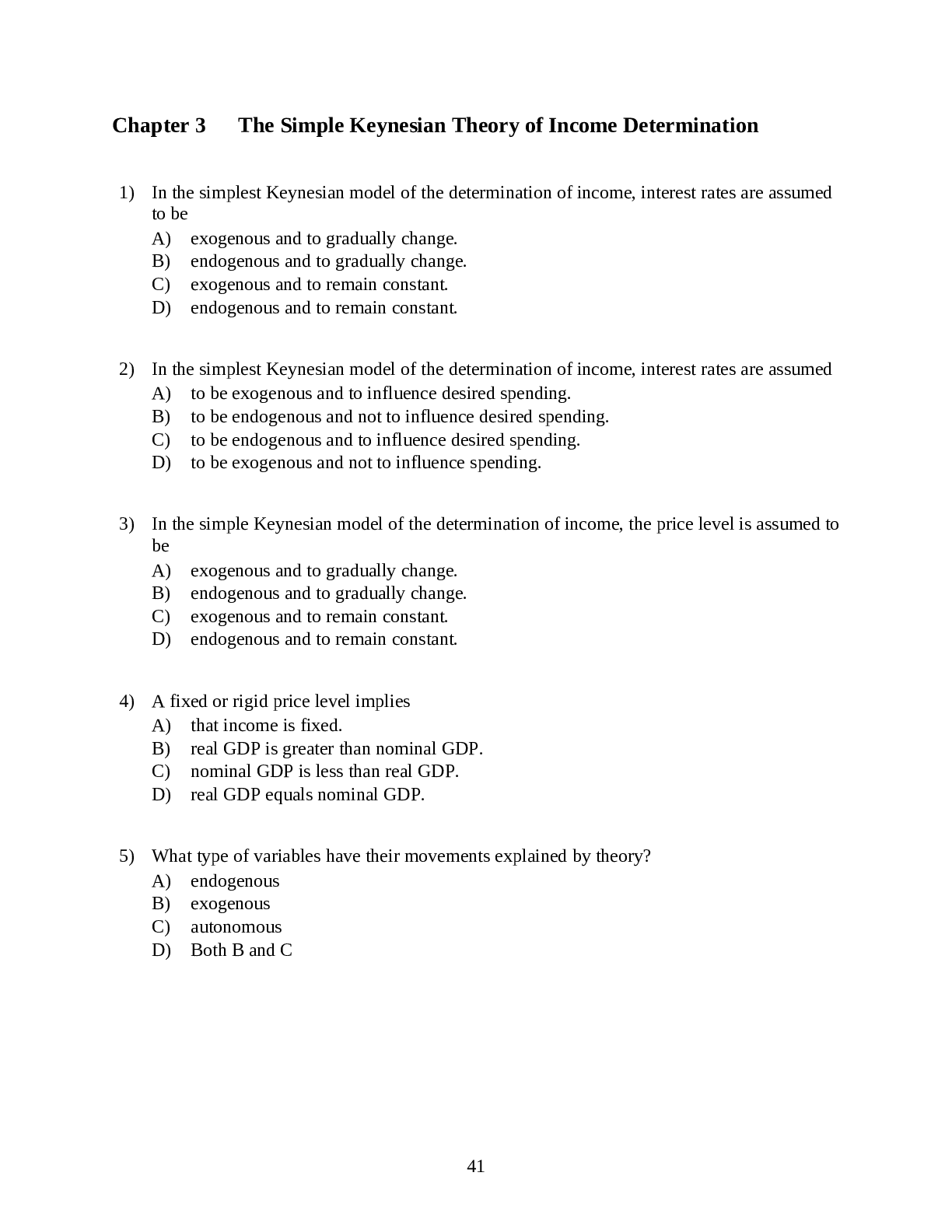
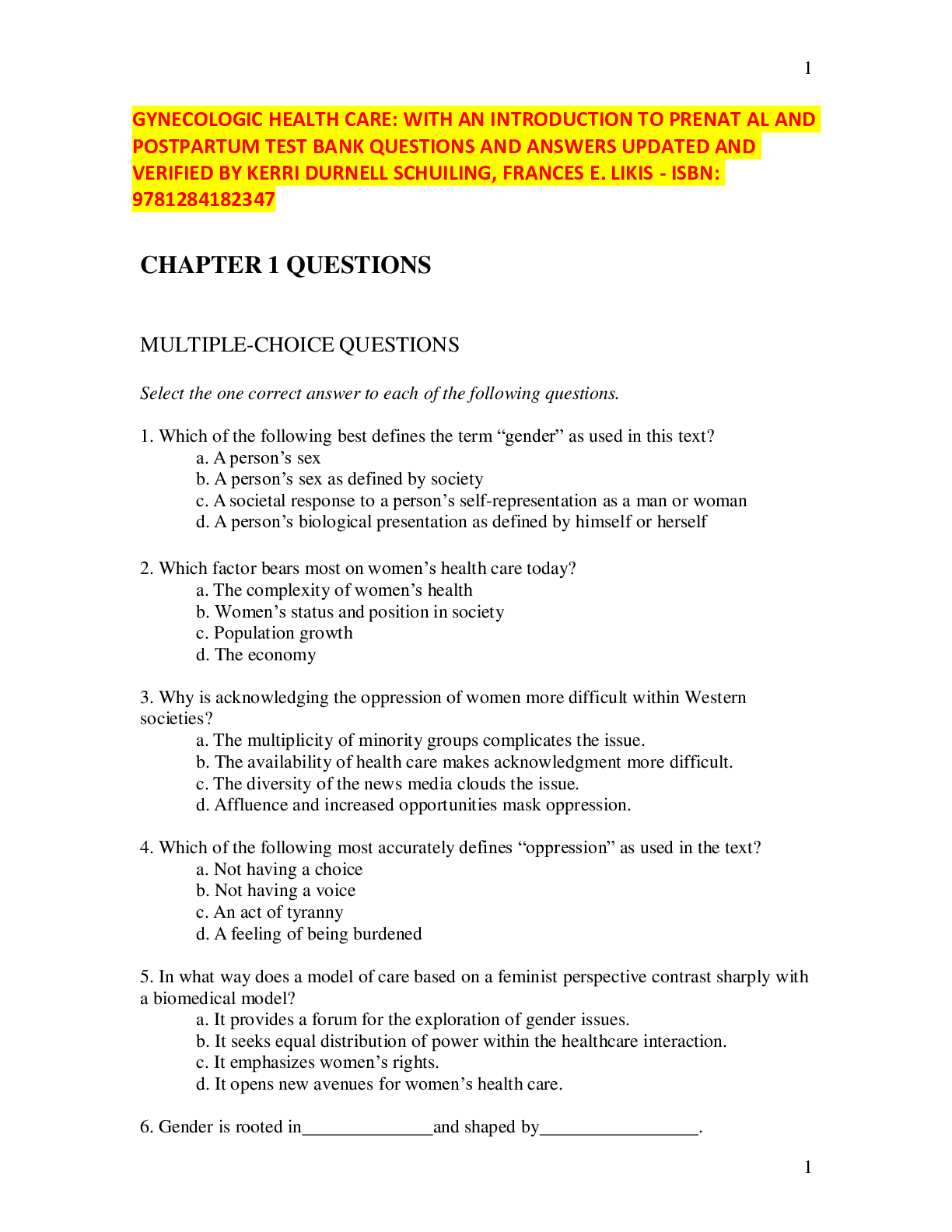
.png)






.png)





